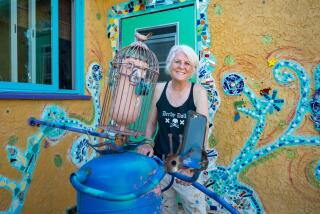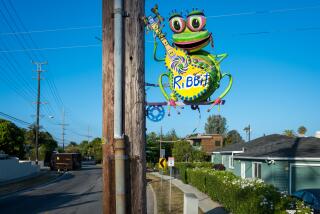Carlsbad Council Aims for Compromise With Creator of Sculpture
- Share via
The Carlsbad City Council will try to reach a compromise with a New York artist who created the controversial “Split Pavilion” sculpture, unpopular with many local residents because of its tall bars.
If that doesn’t work, if she refuses to help change her creation to something deemed more acceptable by residents, the city might end up taking artist Andrea Blum to court, according to a motion approved unanimously by the council Tuesday night.
That move is unlikely to appease vocal opponents who have waged a months-long “Remove the Bars” campaign. They have gathered more than 12,000 signatures from tourists and residents on petitions demanding that the city either remove the metal fence separating the park from Carlsbad Boulevard or remove the whole pavilion.
“Either all of the bars, or all of the people on this City Council need to go,” said Carlsbad resident Debby Blair, drawing applause in the midst of an often heated debate that lasted more than two hours.
“I think the Split Pavilion is ugly,” 12-year-old Laura Haugen said. “Carlsbad beach is too beautiful to have these bars.”
The pavilion, on a prominent piece of city property overlooking the beaches, was created under a city arts program aimed at beautifying Carlsbad with pieces of original art.
Eventually costing about $390,000 in city redevelopment funds, the park was designed by Blum under a contract signed in 1987 after what city staffers have said were numerous public hearings that attracted little or no controversy.
Now, with opposition increasing, council members said they are afraid of doing too much or acting too quickly because they could involve the city in a costly lawsuit.
Acting City Atty. Ronald Ball warned the council Tuesday that two laws, one state and one federal, give artists the right to control what happens to their pieces of public art once they are created.
In lawsuits involving similar issues across the country, cities have been sued, lost, and have had to pay damages to the artists, said Ball.
So, in an attempt at compromise Tuesday, the council directed its staff to seek a signed agreement with Blum allowing the city to change the landscaping and remove the fence from at least the north side of the pavilion.
In a visit to the city last month, Blum tentatively agreed to the landscape change and also said she would consider removing the north-side fence.
Once that work is completed, council members said Tuesday, if people still don’t like the pavilion, then the city will try to get Blum to waive her rights so that the city can do what it wants to the art work.
More to Read
Sign up for Essential California
The most important California stories and recommendations in your inbox every morning.
You may occasionally receive promotional content from the Los Angeles Times.










